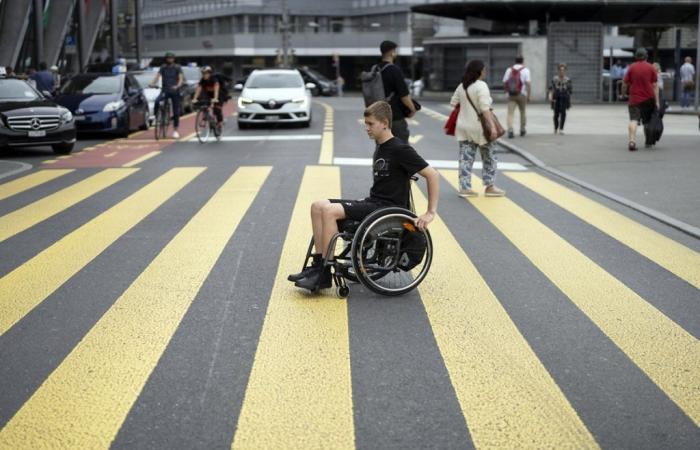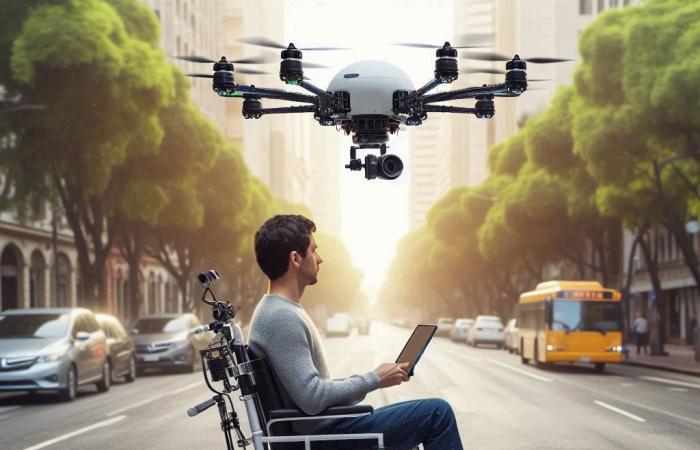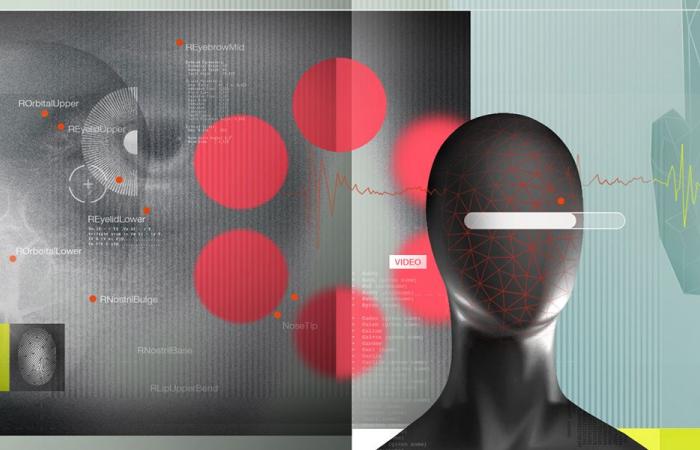Getting a robotic wheelchair to cross the street safely and autonomously is one of the biggest challenges developers face.
Gaetan Bally
A Swiss research group is developing a wheelchair guided by artificial intelligence and a drone. The objective is to enable people with disabilities to lead more independent lives and to feel better integrated into society. However, many technical, ethical and legal obstacles remain.
This content was published on
October 14, 2024 – 09:45
Leading an ordinary existence, choosing where to live and integrating into society: these are the demands of people with disabilities in Switzerland formulated in the popular initiative “for inclusion”. According to the initiators, people with disabilities (1.7 million in Switzerland) remain deprived of the fundamental rights enjoyed by people without disabilities, such as freedom of movement.
Researchers from several Swiss and international universities are working to solve the problem using technology. One of the projectsExternal link aims to develop a self-piloted wheelchair, assisted by a drone.
Plus
Plus
Want to know more? Subscribe to our newsletter
Subscribe to our newsletter for the Fifth Switzerland and receive our best articles in your inbox every day.
read more Want to know more? Subscribe to our newsletter
“We are convinced that our chair will allow people with physical and sensory disabilities to move independently, without being carried around like objects,” says Francesco Flammini, of the Dalle Molle Institute for Artificial Intelligence Research in Lugano, Italy. Ticino. He is responsible for the research team leading this project funded by the European Union and the Swiss government.
His team is collaborating with several other European universities to realize a “disruptive” idea, as he calls it. The idea is to create an intelligent tool that will allow people with disabilities to carry out everyday trips, such as going to work or to the doctor or even visiting friends, without needing help.

Francesco Flammini is professor of autonomous systems security at the Dalle Molle Institute for the Study of Artificial Intelligence (USI-SUPSI).
IDSIA
The “transformative technology” of smart wheelchairs
“A smart wheelchair represents a transformative technology for people who suffer from severe disabilities, often confined to bed and unable to move around,” notes Benjamin Kuipers, professor emeritus of electrical and computer engineering at the University of Michigan, in the United States.
With his team, Benjamin Kuipers has been working on the development of robotic wheelchairs for years. Between two and five million people with disabilities in the United States could benefit. Benjamin Kuipers has looked at length at the ethical questions that arise, particularly that of trusting robots to accomplish tasks autonomously. “To collaborate with humans, the robot must be trustworthy,” he emphasizes.
Benjamin Kuipers and two of his students show off their robotic wheelchair in this video:
External content
Resolving these essential ethical questions is a challenge. This is why many innovative ideas developed in universities have not yet reached the commercial stage. Also, the wheelchair projects of Benjamin Kuipers and Francesco Flammini still have a long way to go before being implemented.
“The challenges we face are very significant. We are developing prototypes which will take several years to industrialise,” says Francesco Flammini.

Benjamin Kuipers is Professor Emeritus of Electrical and Computer Engineering at the University of Michigan, USA.
University of Michigan
Crossing the road independently: a challenge
Enabling a wheelchair to cross a road safely and independently is one of the biggest challenges designers face. Francesco Flammini’s research group carried out the test at the software level, simulating various real-life situations (rain, fog, poor visibility), and proved that it could work, even in the case of people with disabilities. mental and sensory such as visual impairments. The operation is possible thanks to a series of integrated sensors and cameras, like autonomous cars. With the help of drones, which are an integral part of the Swiss project, the wheelchair can assess the situation and the danger threshold from different angles and perspectives, before deciding whether it can cross the road.
“The advantage of drones is that they can move and fly around corners and beyond the human field of vision,” explains Francesco Flammini. To assess whether crossing is safe, the system calculates the risk threshold using a mathematical function.
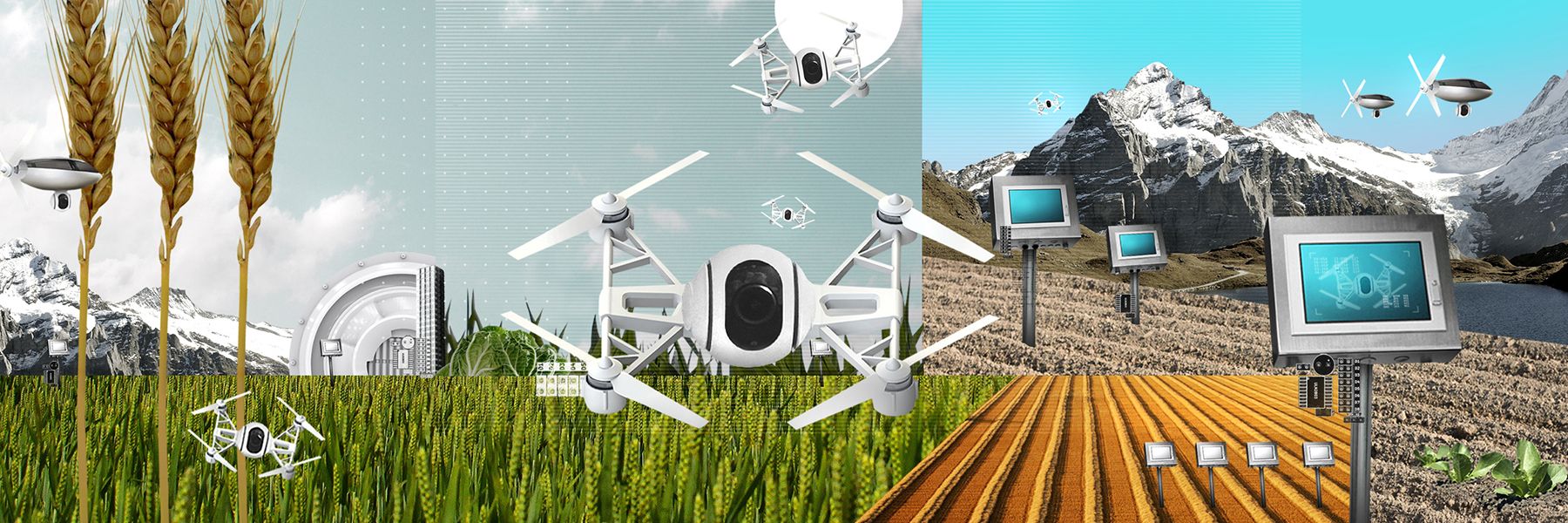
Plus
Switzerland, laboratory for tomorrow’s robots
Less known than watches, chocolate, pharma or space technologies, Switzerland has another great specialty: robotics.
read more Switzerland, laboratory for tomorrow’s robots
Are drones too intrusive, or crucial for security?
However, Benjamin Kuipers has doubts about the feasibility of the Swiss project.
“People with disabilities don’t want to attract people’s attention. A wheelchair surrounded by drones is very conspicuous,” points out the American professor. According to him, the Lugano research team should take this aspect into account and survey potential users.
Francesco Flammini believes that the security of autonomous devices depends on the exploitation of as much information as possible, including that provided by drones. “The more sensors there are, the more information we have, which increases the reliability of the robot’s decisions,” he explains.

The drone-driven wheelchair developed by Flammini and his team, in an AI-generated image.
Francesco Flammini / IA
Understand how it works to trust
The AI-based systems that control self-driving trains or nuclear power plants are certainly complex, but follow simple principles. Those that apply to wheelchairs, on the other hand, operate in complex environments and their actions cannot always be completely explained. In the event of an accident, it will be difficult to determine who is responsible and what happened if the system is not transparent. The same difficulties arise for autonomous cars.
“We cannot trust systems whose functioning we do not understand,” points out Francesco Flammini. The researcher and his team tried to solve the problem by explaining most of the processes using mathematical formalisms. However, their system still relies in part on deep learning, which often has biases in the data. “For example, if an AI system has to recognize a wolf from a dog and it is trained only with images of wolves in the snow, it will have difficulty recognizing it in other contexts,” illustrates the researcher.
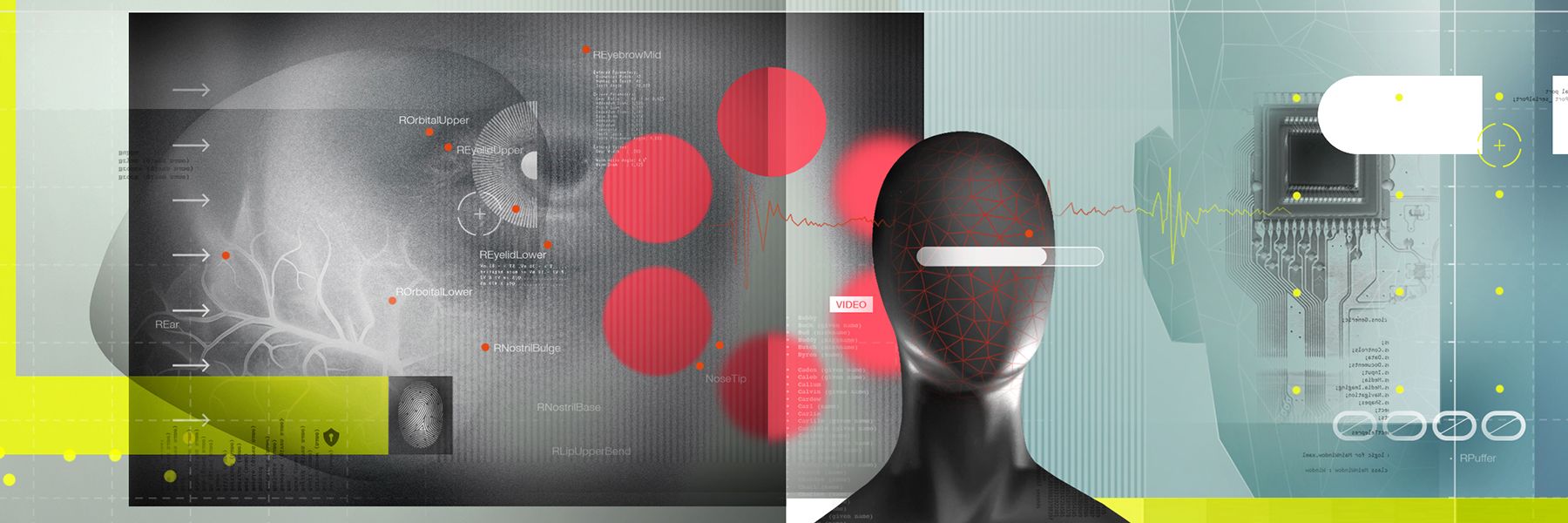
Plus
The machine and morality
Big ethical challenges for Switzerland, one of the most advanced countries in the field of artificial intelligence.
read more The machine and morality
Ethics and legal impasse
The lack of transparency in the system causes both operational and legal problems, as it is difficult to assign responsibility in the event of an error or accident.
“Where is the error? In the software, in the sensors? Is it the company’s fault or a third party? Opaque systems cannot be used in critical contexts,” raises Francesco Flammini. To be acceptable, the probability of an accident must also be measurable and remain below a certain threshold. For trains and planes, we speak of a probability “less than 10-9», a threshold that AI systems cannot currently guarantee, notes Francesco Flammini.
This threshold determines whether a robot is truly reliable. This is a crucial point when working with humans.
“The human delegates some of the responsibility to the robot to take it to the doctor or to work, hoping that it will avoid dangerous situations. For this, the robot must be reliable,” notes Benjamin Kuipers. At the same time, the robot must refuse to voluntarily or involuntarily carry out commands that can lead to death such as going down a ladder or going through a window. “These are very important ethical questions.”
Another challenge for Francesco Flammini’s wheelchair project: the absence of legislation regulating the flight of drones in public and urban spaces.
Robots serving humans
Despite the many obstacles, the Lugano team is convinced that they are moving in the right direction. “Our visionary and disruptive project opens new perspectives on how to help people with disabilities and improve their inclusion and autonomy,” declares Francesco Flammini.
According to Benjamin Kuipers, the greatest potential of this technology lies in using the robot as a scientific research tool, for example to explore and map spatial environments or to better study the interaction between humans and machines. “The human being is always in charge. The robot must live and exist to serve us,” he concludes.
Text reread and verified by Veronica De Vore/sb, translated from English by Zélie Schaller
Plus
Artificial intelligence, progress or threat?
To what extent should we let artificial intelligence enter our lives and make decisions for us?
See the discussion

